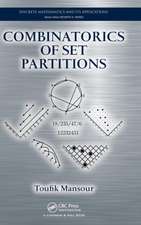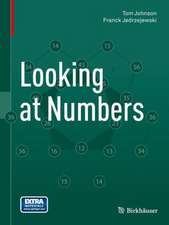Visualization and Mathematics: Experiments, Simulations and Environments
Editat de H.-C. Hege, K. Polthieren Limba Engleză Paperback – 28 oct 2012
Applications of visualization in mathematical research and the use of mathematical methods in visualization have been topic of an international workshop in Berlin in June 1995. Selected contributions treat topics of particular interest in current research. Experts are reporting on their latest work, giving an overview on this fascinating new area. The reader will get insight to state-of-the-art techniques for solving visualization problems and mathematical questions.
| Toate formatele și edițiile | Preț | Express |
|---|---|---|
| Paperback (1) | 338.16 lei 43-57 zile | |
| Springer Berlin, Heidelberg – 28 oct 2012 | 338.16 lei 43-57 zile | |
| Hardback (1) | 651.51 lei 43-57 zile | |
| Springer Verlag – 24 iul 1997 | 651.51 lei 43-57 zile |
Preț: 338.16 lei
Preț vechi: 422.70 lei
-20% Nou
Puncte Express: 507
Preț estimativ în valută:
64.73€ • 70.33$ • 54.41£
64.73€ • 70.33$ • 54.41£
Carte tipărită la comandă
Livrare economică 21 aprilie-05 mai
Preluare comenzi: 021 569.72.76
Specificații
ISBN-13: 9783642638916
ISBN-10: 3642638910
Pagini: 412
Ilustrații: XIX, 388 p. 199 illus., 45 illus. in color.
Dimensiuni: 155 x 235 x 22 mm
Greutate: 0.58 kg
Ediția:Softcover reprint of the original 1st ed. 1997
Editura: Springer Berlin, Heidelberg
Colecția Springer
Locul publicării:Berlin, Heidelberg, Germany
ISBN-10: 3642638910
Pagini: 412
Ilustrații: XIX, 388 p. 199 illus., 45 illus. in color.
Dimensiuni: 155 x 235 x 22 mm
Greutate: 0.58 kg
Ediția:Softcover reprint of the original 1st ed. 1997
Editura: Springer Berlin, Heidelberg
Colecția Springer
Locul publicării:Berlin, Heidelberg, Germany
Public țintă
ResearchCuprins
I. Visualizing Mathematics.- The Minimax Sphere Eversion.- Exploring Plane Hyperbolic Geometry.- Visualizing Nonlinear Electrodynamics.- The Use of Computer Graphics for Solving Problems in Singularity Theory.- What Should a Surface in 4-Space Look Like?.- Animation of Algebraic Surfaces.- II. Geometric Algorithms and Experiments.- Using Symmetry Features of the Surface Evolver to Study Foams.- Constant Mean Curvature Surfaces Derived from Delaunay’s and Wente’s Examples.- Visualization of Periodic Tilings.- An Algorithm for Discrete Constant Mean Curvature Surfaces.- III. Visualization Algorithms and Data Structures.- Efficient Calculation of Subdivision Surfaces for Visualization.- Fast Line Integral Convolution for Arbitrary Surfaces in 3D.- Visualization of Parallel Data based on Procedural Access.- IV. Visualization Environments.- A new 3D Graphics Library: Concepts, Implementation, and Examples.- A Generic Approach to Computer Graphics.- MRT — A Visualization Tool Addressing Problems ‘outside’ the Classical Rendering Domain.- Oorange: A Virtual Laboratory for Experimental Mathematics.- Linear Inductive Reductive Dataflow System for ViSC.- See what I mean? Using Graphics Toolkits to Visualise Numerical Data.- V. Visualization and Simulation Techniques.- Numerical Algorithms and Visualization in Medical Treatment Planning.- Level Set Methods for Curvature Flow, Image Enchancement, and Shape Recovery in Medical Images.- Numerical Methods, Simulations and Visualization for Compressible Flows.- Appendix: Color Plates.
Textul de pe ultima copertă
Visualization and mathematics have begun a fruitful relationship, establishing many links between problems and solutions of both fields. In some areas of mathematics, such as numerical mathematics and differential geometry, visualization techniques are applied with great success. On the other hand, visualization methods are relying heavily on mathematical concepts.
Applications of visualization in mathematical research as well as the use of mathematical methods in visualization have been topic of an international workshop in Berlin in June 1995. Selected contributions treat topics of particular interest in current research, addressing subjects like visualization of mathematical spaces, visualization and simulation techniques, mathematical experiments, graphics environments, and description and modeling of geometric objects. Experts in these fields are reporting on their latest work, giving an overview on this fascinating new area. The reader will get insight to state-of-the-art techniques for solving visualization problems and mathematical questions.
Applications of visualization in mathematical research as well as the use of mathematical methods in visualization have been topic of an international workshop in Berlin in June 1995. Selected contributions treat topics of particular interest in current research, addressing subjects like visualization of mathematical spaces, visualization and simulation techniques, mathematical experiments, graphics environments, and description and modeling of geometric objects. Experts in these fields are reporting on their latest work, giving an overview on this fascinating new area. The reader will get insight to state-of-the-art techniques for solving visualization problems and mathematical questions.
Descriere
Descriere de la o altă ediție sau format:
This book is based on an international workshop held in Berlin in 1995. The workshop was met with great approval by mathematicians and computer graphic experts. It was considered a link between the fields "Visualization in Mathematics" and "Mathematical Methods in Computer Graphics".
This book is based on an international workshop held in Berlin in 1995. The workshop was met with great approval by mathematicians and computer graphic experts. It was considered a link between the fields "Visualization in Mathematics" and "Mathematical Methods in Computer Graphics".

















